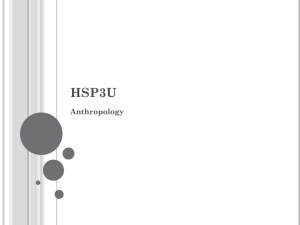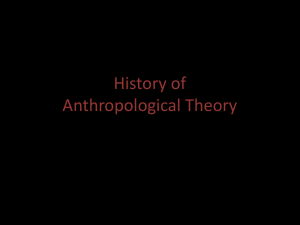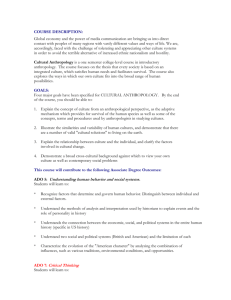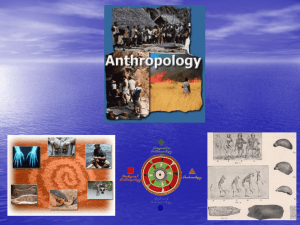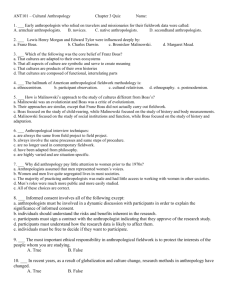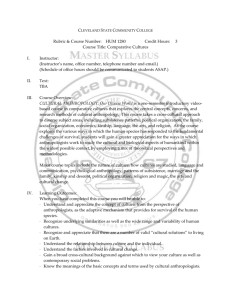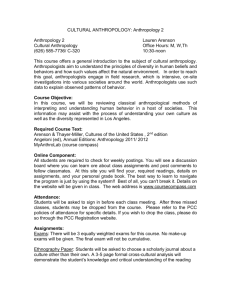What+is+Culture+Yudice
advertisement
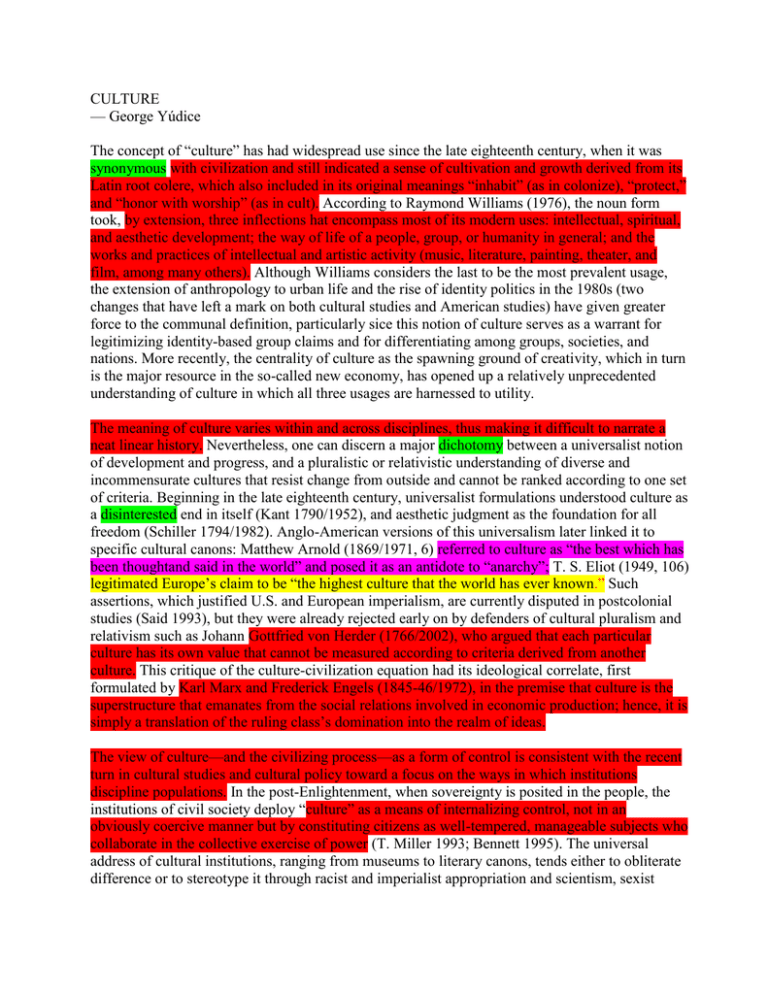
CULTURE — George Yúdice The concept of “culture” has had widespread use since the late eighteenth century, when it was synonymous with civilization and still indicated a sense of cultivation and growth derived from its Latin root colere, which also included in its original meanings “inhabit” (as in colonize), “protect,” and “honor with worship” (as in cult). According to Raymond Williams (1976), the noun form took, by extension, three inflections hat encompass most of its modern uses: intellectual, spiritual, and aesthetic development; the way of life of a people, group, or humanity in general; and the works and practices of intellectual and artistic activity (music, literature, painting, theater, and film, among many others). Although Williams considers the last to be the most prevalent usage, the extension of anthropology to urban life and the rise of identity politics in the 1980s (two changes that have left a mark on both cultural studies and American studies) have given greater force to the communal definition, particularly sice this notion of culture serves as a warrant for legitimizing identity-based group claims and for differentiating among groups, societies, and nations. More recently, the centrality of culture as the spawning ground of creativity, which in turn is the major resource in the so-called new economy, has opened up a relatively unprecedented understanding of culture in which all three usages are harnessed to utility. The meaning of culture varies within and across disciplines, thus making it difficult to narrate a neat linear history. Nevertheless, one can discern a major dichotomy between a universalist notion of development and progress, and a pluralistic or relativistic understanding of diverse and incommensurate cultures that resist change from outside and cannot be ranked according to one set of criteria. Beginning in the late eighteenth century, universalist formulations understood culture as a disinterested end in itself (Kant 1790/1952), and aesthetic judgment as the foundation for all freedom (Schiller 1794/1982). Anglo-American versions of this universalism later linked it to specific cultural canons: Matthew Arnold (1869/1971, 6) referred to culture as “the best which has been thoughtand said in the world” and posed it as an antidote to “anarchy”; T. S. Eliot (1949, 106) legitimated Europe’s claim to be “the highest culture that the world has ever known.” Such assertions, which justified U.S. and European imperialism, are currently disputed in postcolonial studies (Said 1993), but they were already rejected early on by defenders of cultural pluralism and relativism such as Johann Gottfried von Herder (1766/2002), who argued that each particular culture has its own value that cannot be measured according to criteria derived from another culture. This critique of the culture-civilization equation had its ideological correlate, first formulated by Karl Marx and Frederick Engels (1845-46/1972), in the premise that culture is the superstructure that emanates from the social relations involved in economic production; hence, it is simply a translation of the ruling class’s domination into the realm of ideas. The view of culture—and the civilizing process—as a form of control is consistent with the recent turn in cultural studies and cultural policy toward a focus on the ways in which institutions discipline populations. In the post-Enlightenment, when sovereignty is posited in the people, the institutions of civil society deploy “culture” as a means of internalizing control, not in an obviously coercive manner but by constituting citizens as well-tempered, manageable subjects who collaborate in the collective exercise of power (T. Miller 1993; Bennett 1995). The universal address of cultural institutions, ranging from museums to literary canons, tends either to obliterate difference or to stereotype it through racist and imperialist appropriation and scientism, sexist exclusion and mystification, and class-based narratives of progress. Populations that “fail” to meet standards of taste or conduct, or that “reject culture” because it is defined against their own values, are subject to constitutive exclusion with n these canons and institutions (Bourdieu 1987). Challenges to these exclusions generate a politics of representational proportionality such that culture becomes the space of incremental incorporation whereby diverse social groups struggle to establish their intellectual, cultural, and moral influence over each other. Rather than privilege the role of the economic in determining social relations, this process of hegemony, first described by Antonio Gramsci (1971, 247), pays attention to the “multiplicity of fronts” on which struggle must take place. The Gramscian turn in cultural studies (American and otherwise) is evident in Williams’s (1977/97, 108–9) incorporation of hegemony into his focus on the “whole way of life”: “[Hegemony] is in the strongest sense a ‘culture,’ but a culture which has also to be seen as the lived dominance and subordination of particular classes.” But hegemony is not synonymous with domination. It also names the realm in which subcultures and subaltern groups wield their politics in the registers of style and culture (Hebdige 1979). Indeed, in societies like the United States, where needs are often interpreted in relation to identity factors and cultural difference, culture becomes a significant ground for extending a right to groups that have otherwise been excluded on those terms. The very notion of cultural citizenship implies recognition of cultural difference as a basis for making claims. This view has even been incorporated in epistemology to capture the premise that groups with different cultural horizons have different and hence legitimate bases for construing knowledge; they develop different “standpoint epistemologies” (Haraway 1991; Delgado Bernal 1998). The problem is that bureaucracies often establish the terms by which cultural difference is recognized and rewarded. In response, some subcultures (and their spokespersons) reject bureaucratic forms of recognition and identification, not permitting their identities and practices to become functional in the process of “governmentality,” the term Michel Foucault (1982, 21) uses to capture “the way in which the conduct of individuals or groups might be directed.” On this view, strategies and policies for inclusion are an exercise of power through which, in the U.S. post–civil rights era, institutional administrators recognize women, “people of color,” and gays and lesbians as “others” according to a multiculturalist paradigm, a form of recognition that often empowers those administrators to act as “brokers” of otherness (Cruikshank 1994). These contemporary struggles over cultural citizenship and recognition can be traced to earlier battles over the attributes according to which anthropologists and sociologists in the 1950s and 1960s catalogued certain non-European and minority populations as “cultures of poverty.” This diagnostic label, first formulated by Oscar Lewis in 1959, references the presumed characterological traits—passivity, apathy, and impulsivity—that in underdeveloped societies impede social and economic mobility. We see at work here the narrative of progress and civilization that had been the frame within which anthropology emerged more than a hundred years earlier. Most anthropologists’ method had been comparative in a non-relativistic sense, as they assumed that all societies passed through a single evolutionary process from the most primitive to the most advanced. Culture, which has been variously defined as the structured set or pattern of behaviors, beliefs, traditions, symbols, and practices (Tylor 1871; Boas 1911; Benedi ct 1934; Mead 1937; Kroeber and Kluckhohn 1952) by means of which humans “communicate, perpetuate and develop their knowledge about and attitudes toward life” (Geertz 1965, 86), was the ground on which anthropologists, even into the 1920s, sought to track the origins of all societies as well as their progress toward (European and/or Anglo-American) modernity. In partial contrast, the relativist or pluralist cultural anthropology (often associated with Franz Boas) that arose during the 1920s began to critique the scientific racism that underwrote many of these accounts, to question the premise that any such accounting could be objective, and to argue that there were neither superior nor inferior cultures (Boas 1928). Nevertheless, Boas and his U.S. and Latin American followers (Kroeber 1917; Freyre 1933; Benedict 1934; Mead 1937; Ortiz 1946) believed that culture could be studied objectively, as a science, so long as description and analysis were not hamstrung by the anthropologist’s cultural horizon. Many of the U.S. studies were explicitly designed, in Margaret Mead’s words, to “giv[e] Americans a sense of their particular strengths as a people and of the part they may play in the world” (1942/1965, xlii). By the end of the 1950s (coincident with the rise of cultural studies in Britain and American studies in the United States), the Boasian legacy as well as other salient anthropological tendencies such as British structural-functionalism and U.S. evolutionism waned and other trends rose in influence: symbolic anthropology (culture as social and action by means of symbols [Geertz 1965]), cultural ecology (culture as a means of adaptation to environment and maintenance of social systems [M. Harris 1977]), and structuralism (culture as a universal grammar arranged in binary oppositions that rendered intelligible the form of a society [Lévi-Strauss 1963]). These largely systemic analyses then gave way in the 1980s to a focus on practice, action, and agency as the main categories of anthropological explanation, and also to a self-reflexivity that put the very enterprise of cultural analysis in question. Self-reflexive or postmodern anthropology criticized the writing practices of ethnographers for obscuring the power relations that subtend the ethnographic encounter, the status of the knowledge that is derived from that encounter, the relationship of ethnography to other genres (Marcus and Fisher 1986; Clifford and Marcus 1986), and even the analytical and political usefulness of the concept of culture itself (Abu-Lughod 1991; Gupta and Ferguson 1992; R. Fox 1995). Related developments in postcolonial studies focused on transnational hybridity in contradistinction to national cultural homogeneity. With the introduction of television and other electronic media, mass migrations from former colonies to metropolitan centers, and modern transportation and communications technologies, cultures could no longer be imagined as circumscribed by national boundaries. Metaphors like montage and pastiche replaced the melting pot in accounts of Brazilian culture (Schwarz 1970/1992; Santiago 1971/1973), echoing Néstor García Canclini’s description of popular culture as the product of “‘complex hybrid processes’ in which signs from diverse classes and nations’ are combined” (Dunn 2001, 97; García Canclini 1995; Appadurai 1996). More recently, García Canclini (2004) has added access to new information and communication technologies as another dimension to consider when weighing the effects that globalization has on culture-based understandings of difference and equality. For many U.S. scholars, this troubling of culture as a category of analysis opened up a critique of the ways in which culture expanded in the late twentieth century to serve as an almost knee-jerk descriptor of nearly any identity group. While this expansion responds to the political desire to incorporate “cultures of difference” within (or against) the mainstream, it often ends up weakening culture’s critical value. Especially frustrating for critics working in these fields is the cooptation of local culture and difference by a relativism that becomes indifferent to difference, and by a cultural capitalism that feeds off and makes a profit from difference (Eagleton 2000). If a key premise of modernity is that tradition is eroded by the constant changes introduced by industrialization, new divisions of labor, and concomitant effects such as migration and consumer capitalism, recent theories of disorganized capitalism entertain the possibility that the “system” itself gains by the erosion of such traditions, for it can capitalize on them through commodity consumption, cultural tourism, and increasing attention to heritage. In this case, both the changes and the attempts to recuperate tradition feed the political- economic and cultural system; nonnormative behavior, rather than threatening the system in a counter- or subcultural mode, actually enhances it. Such a “flexible system” can make action and agency oriented toward political opposition seem beside the point. While these critical responses to corporate and bureaucratic modes of multicultural recognition are useful, they often lack a grounded account of how the expedient use of culture as resource emerged. Today, culture is increasingly wielded as a resource for enhancing participation in this era of waning political involvement, conflicts over citizenship (I. Young 2000), and the rise of what Jeremy Rifkin (2000, 251) has called “cultural capitalism.” The immaterialization characteristic of many new sources of economic growth (intellectual property rights as defined by the General Agreement on Tariffs and Trade and the World Trade Organization) and the increasing share of world trade captured by symbolic goods (movies, TV programs, music, tourism) have given the cultural sphere greater importance than at any other moment in the history of modernity. Culture may have simply become a pretext for sociopolitical amelioration and economic growth. But even if that were the case, the proliferation of such arguments, in forums provided by local culture-and-development projects as well as by the United Nations Educational Scientific and Cultural Organization (UNESCO), the World Bank, and the so-called globalized civil society of international foundations and nongovernmental organizations (NGOs), has produced a transformation in what we understand by the notion of culture and what we do in its name (Yúdice 2003). Applying the logic that a creative environment begets innovation, urban culture has been touted as the foundation for the socalled new economy based on “content provision,” which is supposed to be the engine of accumulation (Castells 2000b). This premise is quite widespread, with the U.S. and British hype about the “creative economy” echoing in similar initiatives throughout the world (Caves 2000; Landry 2000; Venturelli 2001; Florida 2002). As should be clear, current understandings and practices of culture are complex, located at the intersection of economic and social justice agendas. Considered as a keyword, “culture” is undergoing a transformation that “already is challenging many of our most basic assumptions about what constitutes human society” (Rifkin 2000, 10–11). In the first half of the twentieth century, Theodor Adorno (1984, 25) could define art as the process through which the individual gains freedom by externalizing himself, in contrast to the philistine “who craves art for what he can get out of it.” Today, it is nearly impossible to find public statements that do not recruit art and culture either to better social conditions through the creation of multicultural tolerance and civic participation or to spur economic growth through urban cultural development projects and the concomitant proliferation of museums for cultural tourism, epitomized by the increasing number of Guggenheim franchises. At the same time, this blurring of distinctions between cultural, economic, and social programs has created a conservative backlash. Political scientists such as Samuel Huntington have argued (once again) that cultural factors account for the prosperity or backwardness, transparency or corruption, entrepreneurship or bureaucratic inertia of “world cultures” such as Asia, Latin America, and Africa (Huntington 1996; Harrison and Huntington 2000), while the Rand Corporation’s policy paper Gifts of the Muse: Reframing the Debate about the Benefits of the Arts has resurrected the understanding of culture as referring to the “intrinsic benefits” of pleasure and captivation, which are “central in . . . generating all benefits deriving from the arts” (McCarthy et al. 2005, 12). The challenge today for both cultural studies and American studies is to think through this double-bind. Beyond either the economic and social expediency of culture or its depoliticized “intrinsic” benefits lies its critical potential. This potential is not realizable on its own, but must be fought for in and across educational and cultural institutions. Keywords for American Cultural Studies, 71-76 For other keywords entries on culture, click here.
